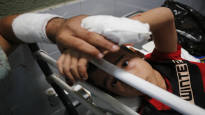According to the UN’s estimate, 70 percent of the thousands of people who died in Gaza are women and children. The images of the victims are brutal, but brutality is not an absolute value in war reporting.
The brutality of the war on children in Gaza is deafening: more children have been killed in three weeks than in any other conflict in more than three years. In terms of child victims, the war is the world’s bloodiest conflict since 2019.
UN aid organization for Palestinian refugees UNRWA estimates on Monday that up to 70 percent of the dead in Gaza are children and women. According to the Save the Children organization, the share of children is more than 40 percent.
About half of the entire population of Gaza are children.
At least 8,800 people have been killed in Israeli counterstrikes in the Gaza Strip during the war that began on October 7, according to an estimate on Wednesday by the Hamas-run Gaza Health Ministry. More than 3,600 of the victims are children.
According to Israel, a total of more than 1,400 Israelis have died as a result of the attack launched by Hamas.
In addition to all of the above, the humanitarian situation in Gaza is extremely weak.
According to the UN, one third of the hospitals in the Gaza Strip are not operational. According to the latest information from the Gaza Ministry of Health, 130 health workers have died, and 15 hospitals and 32 health centers are out of action. In addition, power outages and shortages of fuel and medical supplies plague Gazan hospitals.
The region is completely dependent on humanitarian aid, and civilian suffering is increasing day by day.
visual journalism producer Tatu Blomqvist’s comment: The violent reality of war is conveyed through images
It is our mission to convey information to show what is happening in the war.
Truthful war reporting also includes dead and injured people, a significant proportion of which have been civilians and children in Gaza and Israel.
Images play an important role in reporting, as they act as evidence of events and make people’s experiences more understandable. Behind the numbers are individuals.
However, every publication decision is made carefully and must have solid journalistic grounds. It is important to us that these principles are also comprehensible to the public.
We have daily discussions about posting pictures and videos, and we don’t always agree. Images affect viewers in different ways, and not everyone wants to see everything that someone else finds important.
The publication of war photos generally requires a lot of consideration, because there is a huge amount of pictorial disinformation and propaganda in circulation. The work of journalists is extremely difficult in Gaza, and images, like all information, must be viewed critically.
The journalist’s instructions and our own journalistic principles act as a backbone for decisions. They require us to be tactful when reporting on the victims and remind us that we must be particularly careful when dealing with minors.
Images must be used in accordance with our policy, respecting the human dignity of the victims, both living and dead. For this reason, we do not publish photos in which the face of the deceased can be recognized. We also don’t post unnecessarily detailed pictures of people’s injuries.
With the ongoing war now, we’ve had a lot of discussions about when it’s appropriate to post a picture of a child in distress. Here too, the details matter. Is the child in an adult’s arms or alone? Can we tell the audience what happened to the child next?
For example, we decided not to publish a video showing a close-up of a distressed child’s face while he is being dug out of the ruins of a destroyed house. However, we published videos where only the hand of a child in a similar situation is visible and where the rescued child is transported to treatment. We have also published pictures of the dead.
The raw and violent reality of war will therefore continue to be conveyed in news photos and videos, but carefully. As the journalist’s instructions say: A journalist is responsible above all to his readers, listeners and viewers. The public has a right to know what is happening in the world.
